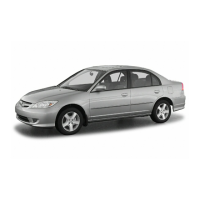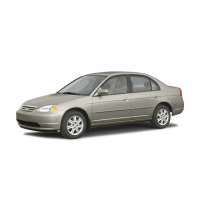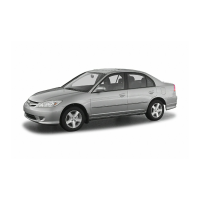
Do you have a question about the Honda Civic Sedan 2005 and is the answer not in the manual?
| Brand | Honda |
|---|---|
| Model | Civic Sedan 2005 |
| Category | Automobile |
| Language | English |
Warns about chemicals in the product known to cause cancer or birth defects.
Informs about the presence of event data recorders in the vehicle.
Explains safety information provided in the manual and its importance for safe driving.
Identifies key controls and components within the vehicle's interior.
Identifies key controls and components on the exterior of the vehicle.
Highlights crucial safety recommendations for all occupants and driving situations.
Describes the built-in safety systems designed to protect occupants during a crash.
Explains the importance and proper use of seat belts for occupant protection.
Details the function, types, and safety considerations of the Supplemental Restraint System (SRS) airbags.
Provides guidelines for safe seating positions and seat belt usage for adults and teenagers.
Offers essential rules for safely restraining children of all ages in the vehicle.
Details the correct use and placement of child seats for infants and young children.
Guides on how to properly seat and restrain larger children, including booster seat use.
Warns about the dangers of carbon monoxide gas and how to avoid exposure.
Identifies the locations and purpose of important safety warning labels on the vehicle.
Shows the location of various controls and switches within the vehicle's cabin.
Illustrates the main instrument panel and identifies key gauges and indicators.
Explains the meaning and function of various warning and indicator lights on the instrument panel.
Describes the vehicle's gauges, including odometer, trip meter, fuel, and temperature readings.
Identifies controls located around the steering wheel for driver convenience.
Details the operation of the windshield wiper and washer system for visibility.
Explains how to operate the turn signals and headlights for road signaling.
Describes how to adjust the illumination level of the instrument panel for nighttime driving.
Explains the function and operation of hazard warning lights and the rear window defogger.
Guides on how to adjust the steering wheel's position for optimal comfort and control.
Covers the types of keys, their functions, and how the vehicle's locking system works.
Explains the vehicle's anti-theft immobilizer system and its indicator light.
Describes the different positions of the ignition switch and their functions.
Details the operation of the vehicle's door locks, including power locks and childproof locks.
Explains how to open and close the vehicle's trunk.
Describes the location and operation of the emergency trunk release lever.
Explains how to use the remote transmitter for locking, unlocking, and panic functions.
Covers adjustments for front seats, including forward/backward and seat-back angle.
Details how to adjust the front seats for optimal position and security.
Explains how to adjust the height of the driver's seat for better visibility.
Guides on proper positioning of head restraints for whiplash protection.
Describes the console compartment lid used as an armrest and how to fold the rear seat.
Details the operation of the vehicle's power windows, including auto function.
Covers the operation of the moonroof and adjustment of interior/exterior mirrors.
Explains how to adjust the vehicle's power side mirrors using the selector and adjustment switches.
Describes the function of heated side mirrors for defogging and defrosting.
Explains how to apply and release the parking brake lever.
Describes the operation of ceiling and individual interior lights.
Details the operation of the vehicle's ceiling light with its multi-position switch.
Explains the courtesy lights in doors and ignition switch illumination.
Lists and describes various interior convenience features like coat hooks and coin boxes.
Provides usage notes and warnings for the vehicle's beverage holders.
Explains the function and limitations of the vehicle's accessory power sockets.
Details how to open and close the glove box and its safety implications.
Describes how to access and use the vehicle's console compartment.
Covers the operation of the vehicle's climate control system, including vents, heating, and air conditioning.
Explains the different air flow modes and vent selections for the climate control system.
Details how to tune, select stations, and adjust audio settings for the vehicle's radio.
Discusses factors affecting radio signal reception and common issues.
Explains how to load, play, and manage discs in the CD player and changer.
Provides guidelines for handling and caring for CDs to prevent damage and ensure proper playback.
Lists common error messages from the CD player and their solutions.
Lists common error messages from the CD changer and their solutions.
Details the operation of the vehicle's optional tape player, including functions and tape care.
Explains the anti-theft system for the audio unit and how to re-enable it after power loss.
Guides on how to set and display the vehicle's clock time.
Explains how to use the cruise control system for maintaining a set speed on highways.
Advises on proper driving practices during the initial 600 miles (1,000 km) for vehicle reliability.
Specifies the recommended type of gasoline and octane rating for optimal engine performance.
Details the steps for safely and correctly refueling the vehicle's fuel tank.
Covers essential procedures for refueling and interacting with gas station equipment.
Explains the procedure for safely opening and closing the vehicle's hood.
Guides on how to properly check and add engine oil, specifying the recommended type.
Details how to check the engine coolant level and add coolant if needed.
Offers tips and driving practices to improve fuel efficiency and reduce consumption.
Discusses the use of Honda accessories and warnings regarding vehicle modifications.
Provides guidance on safely storing and transporting cargo within the vehicle.
Outlines daily checks and adjustments to perform before driving the vehicle.
Explains the correct procedures for starting the engine under various conditions.
Details the operation of the manual transmission, including shifting and braking.
Covers the operation of the automatic transmission, including gear selection and indicators.
Provides instructions and tips for parking the vehicle safely, including parking brake usage.
Explains the vehicle's braking system, including disc and drum brakes, and brake wear indicators.
Describes the function of the ABS system, its indicators, and safety reminders.
States that the vehicle is not designed for towing and doing so may void warranties.
Highlights essential safety precautions and hazards to be aware of during maintenance tasks.
Outlines recommended maintenance intervals for normal and severe driving conditions.
Provides a log for recording completed maintenance services and dates.
Identifies the locations of various fluid reservoirs under the hood.
Guides on how to properly check and add engine oil, specifying the recommended type.
Details the procedure for changing the engine oil and oil filter, including required tools.
Explains how to add and check engine coolant, specifying the recommended type and warnings.
Covers checking the windshield washer fluid level and refilling with the correct fluid.
Details how to check and add automatic transmission fluid, specifying the recommended type.
Guides on checking and adding manual transmission fluid, specifying the recommended type.
Advises on the recommended replacement interval for the timing belt based on driving conditions.
Explains how to check and maintain brake and clutch fluid levels, specifying fluid types.
Guides on checking and adding power steering fluid, including warnings about low levels.
Describes how to clean and lubricate the hood latch assembly for proper function.
Covers replacing various exterior and interior light bulbs, including aiming adjustments.
Provides cleaning instructions for seat belts, floor mats, and replacement of the dust and pollen filter.
Details how to check, replace, and maintain the vehicle's windshield wiper blades.
Discusses tire inspection, maintenance, inflation guidelines, and replacement.
Explains the importance of proper tire inflation and how to check it.
Provides further details on tire inspection, pressure checks, and wear indicators.
Guides on checking the battery's condition, terminals, and indicators.
Offers procedures for preparing the vehicle for extended storage to prevent deterioration.
Explains the use, precautions, and maintenance of the compact spare tire.
Provides step-by-step instructions for safely changing a flat tire using the vehicle's tools.
Helps diagnose and troubleshoot common reasons why the engine may not start.
Details the correct and safe procedure for jump-starting a vehicle with a dead battery.
Guides on how to respond to engine overheating, including identifying causes and immediate actions.
Explains the meaning of the low oil pressure warning light and the necessary actions.
Describes the charging system indicator and what to do if it illuminates.
Explains the check engine light, its causes, and the importance of addressing potential emissions system issues.
Details the function of the brake system warning light and actions for low fluid or pedal issues.
Provides instructions for manually closing the moonroof if the power function fails.
Explains how to check and replace blown fuses to restore electrical functions.
Identifies the locations of the interior and under-hood fuse boxes and lists circuit protection.
Covers types of towing equipment and procedures for safely towing the vehicle.
Explains the location and significance of various vehicle identification numbers, including VIN.
Lists key vehicle dimensions, weights, engine, capacities, and tire specifications.
Details the U.S. DOT grading system for tires, covering treadwear, traction, and temperature.
Explains the markings on tires, including size, load index, speed rating, and identification number.
Discusses the use of oxygenated fuels and their approved percentages for emissions reduction.
Advises on gasoline availability and emissions regulations when driving outside the U.S. and Canada.
Summarizes the vehicle's emissions control systems and their maintenance requirements.
Describes systems like PGM-FI, ignition timing, EGR, and catalytic converters for emissions management.
Emphasizes using genuine Honda replacement parts for emissions systems to ensure compliance.
Explains the function of the catalytic converter and guidelines for its protection.
Covers readiness codes and procedures for passing state emissions tests, especially after battery disconnection.
Provides contact information and procedures for resolving dealership or vehicle issues.
Outlines the different types of warranties covering the vehicle, parts, and accessories.
Explains how to report vehicle safety defects to NHTSA and American Honda.
Lists factory-authorized manuals available for purchase and how to order them.












